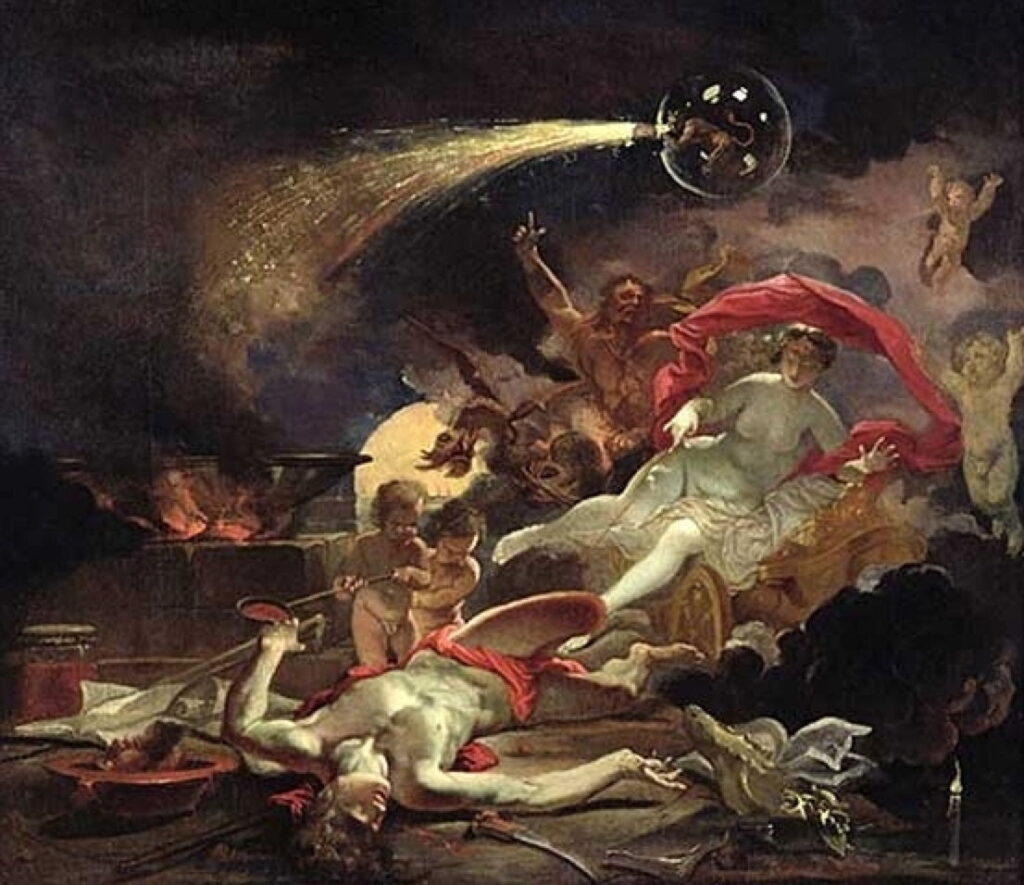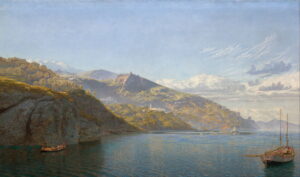Mad, bad and dangerous to know: Paintings of Medea 1

Few women in myth survive as many adventures as Medea, who came to fame with Jason and the Golden Fleece, and was last heard of after her failed attempt to murder Theseus. More than just a femme fatale, she was mad, bad and thoroughly dangerous for all that knew her. This weekend I briefly summarise her sorcery, marriage to Jason, attempted murder by proxy, infanticide, and attempt on the life of the young Theseus, as depicted over the last five centuries of paintings.
Jason had challenged Pelias for his throne, and was given the quest for Poseidon’s Golden Fleece to win it. This took him and his Argonauts to Colchis, where they discovered the owner of the fleece was King Aeëtes, who set Jason three tasks to achieve before he could take possession of the fleece. To ensure his success, Jason enlisted the help of the king’s daughter Medea, already a proficient sorceress, and the inevitable happened when she fell in love with Jason, thanks to the divine intervention of Hera (Juno) through Aphrodite (Venus). In return for her assistance, Jason promised to marry Medea.
John William Waterhouse (1849–1917), Jason and Medea (1907), oil on canvas, 131.4 x 105.4 cm, Private collection. Wikimedia Commons.
John William Waterhouse’s painting of Jason and Medea (1907) shows her preparing the potion which Jason later gives to the dragon guarding the Golden Fleece. Medea wears a dress which suggests, in its bold icons, her role as a sorceress. In front of her, a flame heats ingredients for the potion, which she is adding to a chalice. Jason appears anxious, and is dressed and armed ready to go and fight the dragon.
Elihu Vedder (1836–1923), The Etruscan Sorceress (1886), oil on canvas, 34 x 17.1 cm, Private collection. The Athenaeum.
Although identified as being The Etruscan Sorceress (1886), Elihu Vedder’s painting has all the symbolic associations of Medea. She is holding a vial which Jason used to capture the fleece, and at her feet is an open fire which is associated with preparation of the potion for the vial.
Frederick Sandys (1829–1904), Medea (1866-68), oil on wood panel with gilded background, 61.2 x 45.6 cm, Birmingham Museum and Art Gallery, Birmingham England. Wikimedia Commons.
Frederick Sandys shows Medea (1866-68) at work, preparing a magic potion for one of Jason’s missions. In front of her is a toad, and other ingredients. Behind her, in a gilt frieze, is Jason’s ship the Argo.
Jean François de Troy (1679–1752), The Capture of the Golden Fleece (1742), oil on canvas, 55.6 x 81 cm, The National Gallery, London. Wikimedia Commons.
In Jean François de Troy’s The Capture of the Golden Fleece from 1742, Jason reaches up to take the Golden Fleece from a branch of the oak tree. The artist has interpreted this prize as a lamb of rather modest size. However, the hero’s left foot rests on the body of the dragon, whose nostrils emit steam. To the left of Jason is Medea, dressed as an eastern princess, and surrounding them are the Argonauts, whose ship is seen at the far left, preparing to set sail.
Gustave Moreau (1826–1898), Jason (1865), oil on canvas, 204 × 115 cm, Musée d’Orsay, Paris. Wikimedia Commons.
In spite of her odd omission from the title of Gustave Moreau’s Jason from 1865, the almost naked woman behind Jason is Medea. The ram’s head at the top of the pillar on the left signifies the Golden Fleece, and the dragon that guarded it is shown as the eagle on which Jason is standing, with the broken tip of his javelin embedded in it. This is the more confusing, as in the original story the dragon was put to sleep by one of Medea’s potions, rather than being killed with a javelin.
Yet Medea holds a vial in her right hand, and her body is swathed with the poisonous hellebore plant, one of the standard tools of witchcraft. These may allude to Jason’s future rejection of Medea and her poisoning of his replacement bride, but there is a lot of story between this moment and that later episode.
Moreau provided some clues to his intentions in this painting, in the almost illegible inscriptions on the two phylacteries wound around the column. These bear the Latin:
nempe tenens quod amo gremioque in Iasonis haerens
per freta longa ferar; nihil illum amplexa timebo
(Nay, holding that which I love, and resting in Jason’s arms, I shall travel over the long reaches of the sea; in his safe embrace I will fear nothing)
et auro heros Aesonius potitur spolioque superbus
muneris auctorem secum spolia altera portans
(And the heroic son of Aeson [i.e. Jason] gained the Golden Fleece. Proud of this spoil and bearing with him the giver of his prize, another spoil)
(Cooke, pp 55-56.)
King Aeëtes clearly hadn’t expected Jason’s success, and decided that he wanted to repossess the Golden Fleece and stop his daughter eloping. As the couple sailed away in the Argo, he gave pursuit.
Herbert James Draper (1863–1920), The Golden Fleece (1904), oil on canvas, 155 x 272.5 cm, Bradford Museums, Bradford, England. Wikimedia Commons.
Herbert James Draper shows one account of the tactics employed in The Golden Fleece (1904): Medea throws her brother into the sea, forcing her father to stop to recover him, so allowing the Argo to escape.
The journey of the Argo back to Iolcus was also eventful, with a series of storms taking them to be purified with Circe, an encounter with sirens whose songs are drowned out by the music of Orpheus, one of the Argonauts, and an encounter with the bronze giant Talos on Crete.
With Jason and his Argonauts returned to their homes, there was celebratory feasting. But one person was unable to take part: Jason’s father Aeson, who was too old and nearing death. Jason asked Medea if she could transfer some of his own youth to extend his father’s years. Medea chided Jason for suggesting such an act, which Hecate forbids, but then told him that she would go one better, and try (with Hecate’s consent) to rejuvenate Aeson without using any of Jason’s future life.
For three nights Medea engaged in rituals to seek Hecate’s help, and the goddess sent her chariot to help Medea prepare for the task. The sorceress then took the chariot in her quest for the ingredients required for her magic potion. For nine days and nights, Medea flew round gathering herbs and other arcane substances from the corners of the world.
Medea then built two turf altars, and slaughtered a sheep before preparing her potion. She called for Aeson to be brought out to her, and used a spell to put him to sleep on a bed of magic herbs before sending Jason and others away. She purged the body of Aeson with water, sulphur, and fire, while her potion brewed in a cauldron.
Pellegrino Tibaldi (1527–1596), Medea Rejuvenates Aeson (date not known), fresco, dimensions not known, Palazzo Marescalchi, Bologna, Italy. Wikimedia Commons.
This monochrome image seems to be the only one available of Pellegrino Tibaldi’s fresco of Medea Rejuvenates Aeson, which he painted in the latter half of the sixteenth century. Medea, naked as became traditional in depictions of witchcraft, is shown purging Aeson’s body with water. Pellegrino relocates the event from outdoor turf altars to a more substantial indoor stone trough, around which are scattered jugs and other remnants from Medea’s sorcery. At Aeson’s feet are statues, the most prominent of which shows Hecate.
Domenicus van Wijnen (1661- c 1695), Medea Rejuvenating Aeson (date not known), oil on canvas, 46 × 53 cm, Musée des beaux-arts de Pau, Pau, France. Wikimedia Commons.
About a century later, Domenicus van Wijnen painted his Medea Rejuvenating Aeson (late seventeenth century), invoking alchemy as well as witchcraft. Medea, naked again and reclining in Hecate’s golden chariot, points her wand at the body of Aeson lying on the ground, as she casts a spell. Above her, a glass sphere containing a small devil shoots a trail of flame and sparks like a rocket. Medea is assisted by four putti and has what appears to be Hecate herself behind her, and a full moon is seen rising above the horizon. Scattered around the scene are objects associated with witchcraft, including a glass cauldron, a jar of brown liquid, a sacrificial knife, old books, and a burning candle.
Bartolomeo Guidobono (1654–1709), Medea Rejuvenates Aeson (c 1700), oil on canvas, 173 x 212 cm, Private collection. Wikimedia Commons.
Bartolomeo Guidobono’s Medea Rejuvenates Aeson from about 1700 is more of a puzzle to read, as Medea, now dressed in an unkempt and wild manner, is accompanied by two men. The near-lifeless and pale body of Aeson rests behind her, but a younger man, possibly the rejuvenated Aeson, is materialising under a table. There is now a panoply of symbols associated with magic, including a snake and toad, large tomes of spells on top of which is a lizard, an open fire on a small stand, and an assortment of more normal animals including a dog, fox, and deer. The table in the background has further magical equipment, such as an orrery, and a bat is flying to the right of Medea’s head.
Corrado Giaquinto (1703–1765), Medea Rejuvenating Aeson (1760), oil on canvas, 73.7 x 54.6 cm, Metropolitan Museum of Art, New York, NY. Wikimedia Commons.
Corrado Giaquinto’s splendid Medea Rejuvenating Aeson from 1760 is theatrical in tone. Set outdoors by the arches of a large stone structure, three gods watch Medea work her spells. At the front of the trio is Diana, wearing a crescent moon as a diadem. To the right is Neptune with his spiked crown and trident, and to the left is (probably) Hecate.
Medea stands in a dramatic pose as if on stage, in the midst of casting a spell, her wand held over the inert body of Aeson, which rests on a bed of flowers and leaves. Behind that is a more Christian-looking altar, with candles burning at its sides. There is a cauldron heating over an open fire at the bottom right, and the body of a black sheep on a more classical altar to the left.




